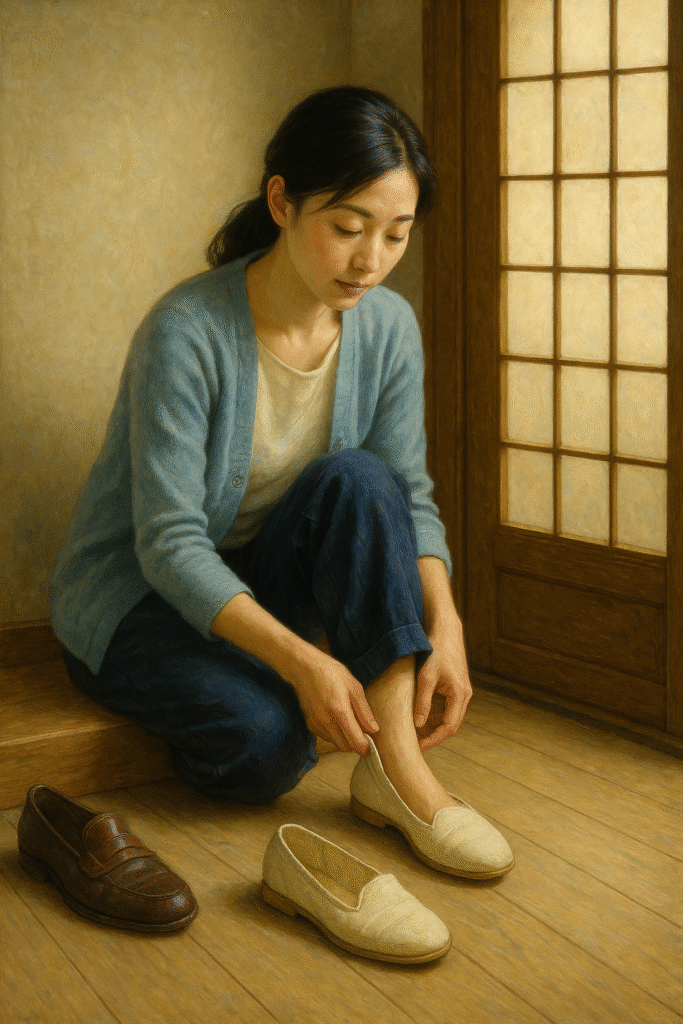Introduction to the Ritual Across Cultures
Removing one’s shoes before entering a home is a widespread practice across many cultures. This ritual, often grounded in respect and cleanliness, varies in its specific cultural contexts but reflects a shared value regarding the sanctity of personal and communal spaces. In this article, we will explore the significance of the shoes-off ritual, analyzing its implications for cleanliness, respect, and personal identity in various societies.
In many traditions, shoes are seen as contaminators that carry dirt, germs, and even negative energies from the outside world into the sanctum of the home. The act of removing shoes is more than a practical measure; it symbolizes a deeper cultural ethos. By examining different practices from around the world, we can draw parallels and distinctions regarding how cleanliness and respect manifest through this simple yet profound act.
Cultural Significance of the Shoes-Off Ritual in Different Societies
1. East Asian Customs: Japan and Korea
In Japan, the ritual of removing shoes is deeply embedded in cultural norms. Traditional Japanese homes are equipped with a genkan, a space designed specifically for removing shoes. Here, guests are encouraged to remove their shoes before stepping onto tatami mats, which are considered sacred and are often used for sitting and sleeping. This practice is not merely about cleanliness; it also conveys respect to the host and their space. In Japan, entering with shoes is viewed as intrusive, as it brings the outside world and its impurities into a home meant for peace and rest.
Similarly, in Korea, the shoes-off custom holds significant cultural weight. Many Korean homes feature ondol, a traditional floor heating system where families often sit on the floor. Shoes are removed to preserve the cleanliness of the living area, reflecting a communal respect for the family space. In both cultures, this ritual instills a sense of discipline and reflects social hierarchy, with guests showing utmost respect for the hosts by adhering to the custom.
2. Middle Eastern Practices: Turkey and Iran
In Middle Eastern countries such as Turkey and Iran, the shoes-off practice is prevalent and deeply ingrained in cultural traditions. Turkish households often consider it disrespectful for shoes to be worn inside the home. The reasoning intertwines cleanliness and respect for others, particularly with the importance of religion and hospitality in Turkish culture. When entering a Muslim household, it is customary to remove shoes to maintain a clean environment for prayer and reflection.
In Iran, removing shoes is similar, integrated with social etiquette and respect towards the inhabitants. Guests are routinely offered slippers or socks after removing their shoes, reflecting hospitality and care. This practice aligns with broader Islamic teachings, which encourage cleanliness and respect, especially when entering sacred spaces.
3. Western Adaptations: The United States and Europe
In contrast to the strong shoes-off cultures of Asia and the Middle East, Western countries like the United States and certain European nations have varied practices. However, there is a growing trend toward shoe removal within homes, especially in urban areas where cleanliness may be more emphasized due to densely populated living conditions.
In recent years, many American families have adopted the shoes-off tradition in response to concerns over hygiene and the spread of allergens. During the COVID-19 pandemic, this practice gained momentum as more people recognized the importance of cleanliness and health. Particularly in homes with children or pets, removing shoes is becoming common to foster a safe and clean environment.
Similarly, in Scandinavian countries such as Norway and Sweden, shoes are often removed in homes, aligning with the cultural value of cleanliness and practicality. Swedish homes typically have designated areas for shoe storage, highlighting an organizational element to the ritual.
4. Indigenous Cultures: Native American Practices
Indigenous practices among Native American communities often reflect a profound respect for the Earth and all living beings. While specific customs can vary among tribes, many adhere to the principle of leaving dirt and contamination outside. The act of removing shoes, along with other rituals, is seen as a way to honor the land and maintain a connection with nature. Such practices symbolize a reverence for the ancestral grounds that families inhabit, highlighting the interconnectedness of identity, respect, and cleanliness.
Relationship Between Cleanliness and Respect in Various Cultures
The relationship between cleanliness and respect can be observed through the lenses of various societies. In many cultures, shoes are considered the physical boundary between the purity of home life and the dirtiness of the outside world. The perceived need to maintain a clean home space is reflective of deeper cultural values about hospitality and respect.
For example, in Indian households, especially in Mumbai, entering a home with shoes is seen as an affront to the host’s familial sanctity. The act conveys a lack of regard for the cleanliness of the living environment, intertwined with the spiritual implications of maintaining a clean space.
In contrast, in countries where shoes may be worn indoors, the lack of emphasis on shoe removal can symbolize a more relaxed or egalitarian approach to space, where individuals prioritize comfort over a strict adherence to cleanliness ideals. In this context, while the shoes-off ritual may not be prevalent, respect and hospitality are still central themes, albeit expressed through different gestures such as welcoming guests into living spaces regardless of their footwear.
Impact of This Ritual on Personal and Collective Identity Formation
The ritual of removing shoes transcends simple hygiene; it is deeply tied to identity formation and social behavior. For individuals, the act of adhering to these cultural norms reinforces personal identity aligned with family values, cultural heritage, and societal expectations. Collective identity is also shaped by the shared values of communities regarding cleanliness and respect, as demonstrated through these rituals.
In Japan, the emphasis on shoe removal has strengthened collective identity through shared customs that promote discipline, respect for tradition, and social harmony. The shoes-off practice communicates a shared understanding of the importance of cleanliness and respect for one’s surroundings, further ingraining cultural values in the populace.
By contrast, in multicultural societies or places experiencing rapid globalization, the integration of the shoes-off custom can indicate negotiations between different cultural identities. For instance, immigrant communities may retain their shoe removal practices as a way to assert cultural pride while encouraging others to adopt similar habits as a means of social integration.
Conclusion Reflecting on Shared Values and Differences
The shoes-off ritual, while varied across cultures, highlights essential shared values concerning cleanliness, respect, and identity. Each practice offers unique insights into how societies navigate their relationships with space, community, and tradition.
In cultures that emphasize cleanliness, such as Japan and Korea, the ritual serves as a means of connection and respect towards one’s home and others. In contrast, cultures where the practice is less stringent, like in the United States, reveal evolving definitions of respect and cleanliness, particularly in contemporary settings.
Ultimately, the ritual of removing shoes presents a fascinating lens to explore broader cultural narratives regarding hygiene, respect, and identity. Whether it’s about honoring the family home, maintaining health standards, or upholding cultural heritage, the shoes-off custom embodies principles that resonate across varied contexts, making it a relevant topic for cultural enthusiasts and social anthropologists alike.
FAQ Section
1. Why do some cultures require removing shoes before entering a home?
Many cultures require shoe removal as a sign of respect for the living space and to maintain cleanliness, as shoes often carry dirt and germs from outside. This practice protects the home environment, making it a more sacred and welcoming space.
2. How does shoe removal relate to personal identity?
The ritual of removing shoes can serve as an expression of personal identity, showcasing adherence to cultural practices and values. It reflects an individual’s connection to their heritage and the respect they have for their community’s customs.
3. Are there cultures where removing shoes is not emphasized?
Yes, in certain Western cultures, the practice of removing shoes is not as strongly emphasized, though attitudes are changing. In some homes, especially in urban settings, people may wear shoes inside, although this may shift due to health concerns.
4. How does the shoes-off ritual impact hospitality?
Removing shoes is often seen as an act of hospitality, not only preserving cleanliness but also inviting guests into a respected and cherished space. Offering slippers or socks after shoe removal is a common practice to enhance the welcoming nature of the host.
5. Is the shoes-off custom more prevalent in urban or rural areas?
The prevalence can vary by culture. In places like Japan or Korea, urban areas typically have stricter adherence to the shoes-off custom due to space constraints and cleanliness concerns in densely populated environments. However, urban American households are increasingly adopting the practice as well.
6. How can I incorporate the shoes-off practice into my home?
To adopt the shoes-off practice, create a designated area near your entrance for shoe storage and consider providing slippers for guests. This makes the transition more comfortable and encourages adherence to the ritual to maintain cleanliness in your home.


